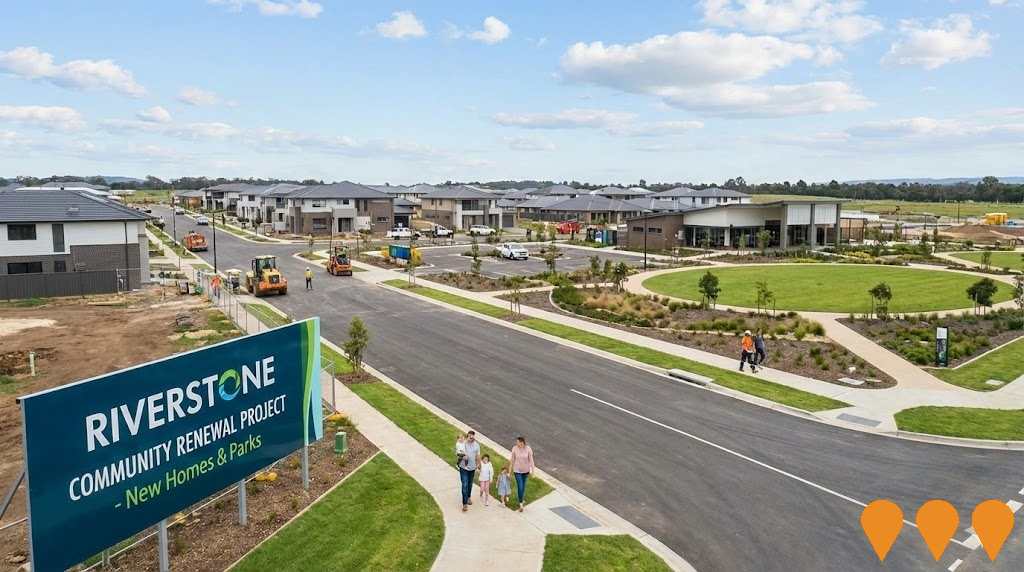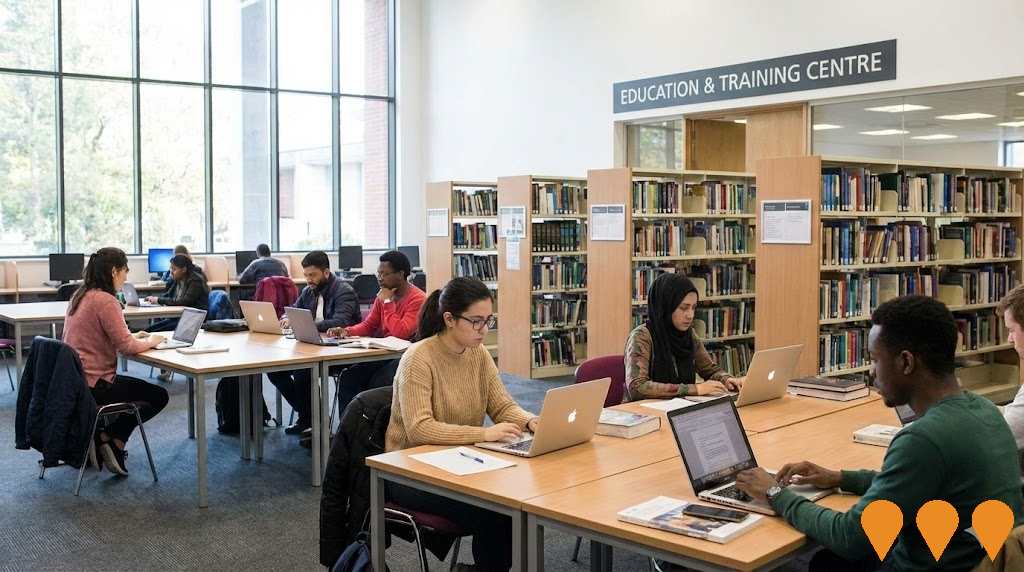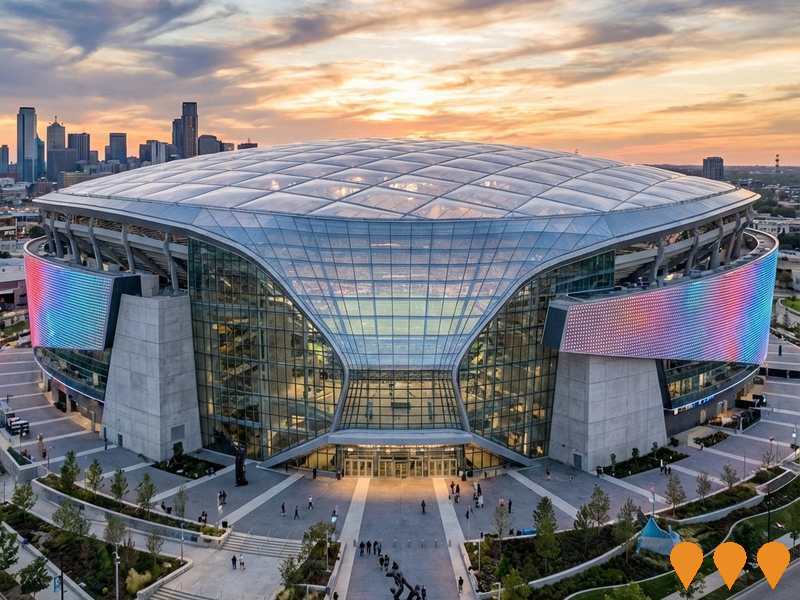Chart Color Schemes
est. as @ -- *
ABS ERP | -- people | --
2021 Census | -- people
Sales Activity
Curious about local property values? Filter the chart to assess the volume and appreciation (including resales) trends and regional comparisons, or scroll to the map below view this information at an individual property level.
Find a Recent Sale
Sales Detail
Population
Craigmore - Blakeview lies within the top quartile of areas nationally for population growth performance according to AreaSearch analysis of recent, and medium to long-term trends
Craigmore-Blakeview's population is approximately 21,402 as of August 2025. This figure reflects an increase of 1,482 people since the 2021 Census, which reported a population of 19,920. The change is inferred from ABS estimates: 21,159 in June 2024 and 202 new addresses validated since the Census date. This results in a population density of 1,801 persons per square kilometer, higher than national averages assessed by AreaSearch. Craigmore-Blakeview's growth rate of 7.4% since the 2021 census exceeds both state (6.7%) and metropolitan area averages. Interstate migration contributed approximately 49.0% to overall population gains recently, with all drivers being positive factors.
AreaSearch uses ABS/Geoscience Australia projections for each SA2 area, released in 2024 with a base year of 2022. For areas not covered and years post-2032, the SA State Government's Regional/LGA projections by age category are adopted, based on 2021 data and adjusted using weighted aggregation methods. Future population projections indicate significant growth in the top quartile of Australian statistical areas, with Craigmore-Blakeview expected to grow by 7,106 persons to 2041, reflecting a 32.1% increase over 17 years.
Frequently Asked Questions - Population
Development
Recent residential development output has been above average within Craigmore - Blakeview when compared nationally
Craigmore-Blakeview averaged approximately 57 new dwelling approvals annually over the past five financial years, from FY21 to FY25, with a total of 288 homes approved during this period. In FY26, up until now, there have been 34 dwelling approvals. This translates to an average of 5.8 new residents per year arriving for each dwelling constructed over the same five-year span.
The demand significantly exceeds the supply of new dwellings, which typically leads to price growth and increased buyer competition. New properties are constructed at an average expected cost value of $329,000, aligning with regional trends. In this financial year, $17.1 million in commercial approvals have been registered, indicating balanced commercial development activity. Compared to Greater Adelaide, Craigmore-Blakeview has significantly less development activity, being 84.0% below the regional average per person. This scarcity of new homes usually strengthens demand and prices for existing properties.
The area's development activity is also lower than the national average, suggesting a mature market with possible development constraints. Recent building activity consists solely of detached houses, maintaining the area's suburban identity with a concentration of family homes suited to buyers seeking space. With around 677 people per dwelling approval, Craigmore-Blakeview reflects a highly mature market. By 2041, Craigmore-Blakeview is projected to grow by approximately 6,863 residents. At current development rates, housing supply may struggle to keep pace with population growth, potentially intensifying buyer competition and supporting price increases.
Frequently Asked Questions - Development
Infrastructure
Craigmore - Blakeview has emerging levels of nearby infrastructure activity, ranking in the 20thth percentile nationally
Changes to local infrastructure significantly impact an area's performance. AreaSearch identified 18 projects likely affecting the region. Notable initiatives include Playford Alive Urban Renewal Project, Bentley Road Affordable Housing Development, Catherine McAuley School Upgrade, and Mark Oliphant College Community Facility. The following list details those most relevant.
Professional plan users can use the search below to filter and access additional projects.
INFRASTRUCTURE SEARCH
 Denotes AI-based impression for illustrative purposes only, not to be taken as definitive under any circumstances. Please follow links and conduct other investigations from the project's source for actual imagery. Developers and project owners wishing us to use original imagery please Contact Us and we will do so.
Denotes AI-based impression for illustrative purposes only, not to be taken as definitive under any circumstances. Please follow links and conduct other investigations from the project's source for actual imagery. Developers and project owners wishing us to use original imagery please Contact Us and we will do so.
Frequently Asked Questions - Infrastructure
Playford Alive Urban Renewal Project
One of Australia's largest urban renewal projects spanning over 1,000 hectares. Partnership between Renewal SA, SA Housing Trust, City of Playford and community. Features new housing for over 40,000 residents, schools, medical centre, railway station, wetlands, parklands and $250 million town centre. Recent 2025 expansion adds 1,300 additional homes with project timeline extended beyond 2028. Includes retail, commercial, civic and community facilities serving the growing northern Adelaide region.

Mark Oliphant College Community Facility
Integrated community facility at Mark Oliphant College delivering a purpose-built kiss 'n' drop (approx. 400 m kerbside zone) with new parking and access upgrades, and a regional-level soccer sportsground featuring a FIFA-quality synthetic pitch, natural pitch, six changerooms, function room and semi-commercial kitchen. Elizabeth Grove Soccer Club is the selected anchor tenant. Jointly funded and delivered by City of Playford and the SA Department for Education.

Angle Vale Residential Growth Area
Major residential growth area with multiple developments including Miravale Estate and The Entrance Estate. Key growth corridor supported by new water infrastructure investments.

Edinburgh Central Mixed Use Development
Premier Defence, Innovation and Technology Hub in northern Adelaide. 3-hectare corner site featuring 8 retail tenancies (Stage 1 complete), 140-place purpose-built childcare centre, 15 mixed use warehouse/office units and 2 commercial buildings (Stage 2 under construction). Located in Edinburgh Defence Precinct near BAE Systems, Defence Science Technology Group and RAAF Base Edinburgh with Zone 3/4 defence compatibility.

Blakes Crossing
90-hectare master-planned community development by Lendlease Group creating home for approximately 4,000 residents. Premium location offering country tranquility with urban convenience. Features town centre, medical facilities, schools, and extensive recreational amenities. Award-winning urban design and sustainable development practices by one of Australia's leading developers.

Catherine McAuley School Upgrade
Multimillion-dollar two-storey building upgrade at this Reception to Year 6 Catholic primary school. The development includes three modern classrooms, a wellbeing centre with therapy consultation spaces, a new student services hub, a dedicated playgroup space for young learners, and revitalized outdoor areas featuring a mini amphitheatre, green spaces, and native gardens. Construction commenced in September 2025, with the facility expected to be ready for Reception 2027 students. The upgrade responds to steadily increasing enrollment over the past three years and strengthens the school's commitment to holistic student wellbeing and community growth.

Craigmore High School Major Upgrades
Major facility upgrade including a new 2-storey learning centre with general learning areas, dance studio, visual arts and music rooms, breakout spaces and staff preparation areas. The project also included an upgrade and extension of the existing gymnasium with air conditioning and 3 new learning spaces, a new modular building with 2 general learning areas, art space, food tech space and additional facilities, provision of additional toilets, and refurbishment of existing toilet and change room facilities. The upgrade provided world-class facilities to support the transition of Year 7 students into high school.

Riverbanks College Angle Vale
New B-12 public school serving the growing Angle Vale community. Riverbanks College B-12 opened in term 1 2022. Modern educational facilities designed for 21st-century learning with STEM labs, creative arts spaces, sports facilities, and sustainable design features. Addressing critical education infrastructure needs in northern Adelaide.

Employment
Craigmore - Blakeview has seen below average employment performance when compared to national benchmarks
Craigmore-Blakeview has a balanced workforce with both white and blue collar jobs. The unemployment rate is 4.6%, with an estimated growth of 1.2% over the past year.
As of June 2025, 10,823 residents are employed while the unemployment rate is 0.6% higher than Greater Adelaide's rate of 4.0%. Workforce participation is similar to Greater Adelaide at 65.1%. The leading employment industries among residents are health care & social assistance, retail trade, and manufacturing. Manufacturing has a particularly notable concentration with employment levels at 1.5 times the regional average.
Professional & technical services have limited presence with only 2.8% of employment compared to the regional average of 7.3%. The area appears to offer limited local employment opportunities as indicated by the count of Census working population versus resident population. Between June 2024 and June 2025, employment levels increased by 1.2%, labour force grew by 1.2%, with unemployment remaining essentially unchanged. This contrasts with Greater Adelaide where employment rose by 2.1% over the same period. Jobs and Skills Australia's national employment forecasts from May 2025 suggest that Craigmore-Blakeview's local employment growth could be approximately 6.0%% over five years and 12.9% over ten years, based on industry-specific projections.
Frequently Asked Questions - Employment
Income
Income levels sit below national averages according to AreaSearch assessment
Craigmore-Blakeview's median income among taxpayers in financial year 2022 was $50,809. The average income stood at $55,687 during the same period. For Greater Adelaide, these figures were $52,592 and $64,886 respectively. Based on Wage Price Index growth of 12.83% since financial year 2022, estimated median income for Craigmore-Blakeview as of September 2025 is approximately $57,328, with the average being around $62,832. According to the 2021 Census, household, family and personal incomes in Craigmore-Blakeview rank modestly, between the 40th and 42nd percentiles. The predominant income cohort spans 38.9% of locals (8,325 people), falling within the $1,500-$2,999 category. After housing costs, 85.0% of income remains for other expenses.
Frequently Asked Questions - Income
Housing
Craigmore - Blakeview is characterized by a predominantly suburban housing profile, with above-average rates of outright home ownership
In Craigmore-Blakeview, as per the latest Census, 98.5% of dwellings were houses, with the remaining 1.5% being semi-detached, apartments, or other types. This contrasts with Adelaide metro's 83.7% houses and 16.2% other dwellings. Home ownership in Craigmore-Blakeview stood at 22.2%, higher than Adelaide metro's level. Mortgaged dwellings made up 51.9%, while rented ones constituted 25.9%. The median monthly mortgage repayment was $1,337, above Adelaide metro's average of $1,300. Median weekly rent in Craigmore-Blakeview was $310, compared to Adelaide metro's $265. Nationally, Craigmore-Blakeview's mortgage repayments were significantly lower than the Australian average of $1,863, and rents were substantially below the national figure of $375.
Frequently Asked Questions - Housing
Household Composition
Craigmore - Blakeview features high concentrations of family households, with a higher-than-average median household size
Family households account for 77.9% of all households, including 35.0% couples with children, 25.4% couples without children, and 16.5% single parent families. Non-family households make up the remaining 22.1%, with lone person households at 19.7% and group households comprising 2.4%. The median household size is 2.8 people, larger than the Greater Adelaide average of 2.6.
Frequently Asked Questions - Households
Local Schools & Education
Craigmore - Blakeview faces educational challenges, with performance metrics placing it in the bottom quartile of areas assessed nationally
The Craigmore-Blakeview area faces notable educational challenges, with university qualification rates at 11.6%, significantly lower than Australia's average of 30.4%. This disparity presents both a challenge and an opportunity for targeted educational initiatives in the region. Bachelor degrees are the most common qualifications (8.5%), followed by postgraduate qualifications (1.6%) and graduate diplomas (1.5%). Vocational credentials are prominent, with 40.4% of residents aged 15+ holding such qualifications - advanced diplomas at 9.6% and certificates at 30.8%.
Educational participation is high, with 30.2% of residents currently enrolled in formal education. This includes 12.8% in primary education, 7.7% in secondary education, and 3.7% pursuing tertiary education. A robust network of eight schools operates within Craigmore-Blakeview, educating approximately 5,189 students as of the latest data. The area demonstrates typical Australian school conditions (ICSEA: 963), with balanced educational opportunities. The educational mix includes four primary, one secondary, and three K-12 schools. School capacity exceeds typical residential needs, with 24.2 places per 100 residents compared to the regional average of 17.1, indicating that Craigmore-Blakeview serves as an educational center for the broader region.
Frequently Asked Questions - Education
Schools Detail
Nearby Services & Amenities
Transport
Transport servicing is low compared to other areas nationally based on assessment of service frequency, route connectivity and accessibility
Craigmore-Blakeview has 73 active public transport stops operating within its boundaries. These stops are served by a mix of bus routes totaling 11 individual routes. Combined, these routes facilitate 744 weekly passenger trips.
The area's transport accessibility is rated good, with residents generally situated about 250 meters from the nearest stop. On average, service frequency across all routes amounts to 106 trips per day, translating to approximately 10 weekly trips per individual stop.
Frequently Asked Questions - Transport
Transport Stops Detail
Health
Health performance in Craigmore - Blakeview is lower than average with common health conditions somewhat prevalent across the board, though to a considerably higher degree among older age cohorts
Craigmore-Blakeview faces significant health challenges with common health conditions prevalent among its population. Older age cohorts experience these conditions to a higher degree compared to younger residents.
Approximately 48% of Craigmore-Blakeview's total population (~10,187 people) has private health cover, which is lower than the national average of 55.3%. Mental health issues and asthma are the most common medical conditions in the area, affecting 10.5% and 9.5% of residents respectively. Conversely, 64.7% of residents declare themselves completely clear of medical ailments compared to 63.4% across Greater Adelaide. The area has a higher proportion of seniors aged 65 and over at 13.8% (2,942 people), with health outcomes among this demographic requiring more attention than the broader population.
Frequently Asked Questions - Health
Cultural Diversity
The level of cultural diversity witnessed in Craigmore - Blakeview was found to be above average when compared nationally for a number of language and cultural background related metrics
Craigmore-Blakeview's cultural diversity is above average, with 21.3% of its population born overseas and 11.5% speaking a language other than English at home. Christianity is the predominant religion in Craigmore-Blakeview, comprising 38.6%. The 'Other' religious category is slightly overrepresented compared to Greater Adelaide (1.1% vs 1.3%).
The top three ancestral groups are English (34.5%), Australian (27.9%), and Other (8.4%). Notably, German ancestry is somewhat higher than the regional average (4.6% vs 4.4%), as are Russian (0.4% vs 0.3%) and Welsh (0.6% vs 0.5%) ancestry.
Frequently Asked Questions - Diversity
Age
Craigmore - Blakeview hosts a young demographic, positioning it in the bottom quartile nationwide
Craigmore-Blakeview has a median age of 34 years, which is lower than Greater Adelaide's average of 39 and Australia's median of 38. Compared to Greater Adelaide, Craigmore-Blakeview has a higher proportion of residents aged 5-14 (15.1%) but fewer residents aged 75-84 (4.4%). Between the 2021 Census and the present day, the population aged 65-74 has increased from 6.8% to 7.8%, while the 45-54 age group has decreased from 12.3% to 11.4%. By 2041, demographic modeling indicates significant changes in Craigmore-Blakeview's age profile. The 45-54 cohort is projected to grow by 45%, adding 1,098 residents and reaching a total of 3,538.


